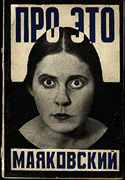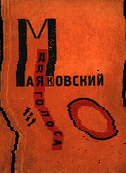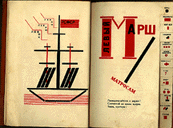
CONSTRUCTIVIST BOOKS

|
 
|
(A. Rodchenko) V. Mayakovsky
Moscow, 1923. Edition: 3,000.
Despite his own rhetoric about the need to eliminate the themes of love and personal emotion from art and literature for the sake of the revolution, Mayakovsky's Pro Eto is the result of the trials which he endured during the two-month separation between himself and his lover, Lily Brik, from December of 1921 to February, 1922. The photomontages and cover portrait of Brik by Rodchenko are among the most widely recognized images of Russian Constructivism and the Avant-garde, and contribute to the poem to such a degree that Rodchenko is often cited as "co-author." Combining photographs of Lily and Mayakovsky with images of skyscrapers, jazz-men, airplanes and zoo animals in cages, each montage relates to the theme and mood of the piece, and refers to actual events from the affair. Praised as being "technically flawless," and the perfect companion pieces to Mayakovsky's writing, Rodchenko's montages are considered to be equally impressive, whether in the book or on their own.
(Howard Schickler)

|

|
Dlya Golosa (For the Voice)
(El Lissitzky) V. Mayakovsky
Berlin, 1923. Cover, title page photo-montage, and book design by Lissitzky.
Design elements such as an alphabetical thumb-index make this one of the most significant experiments with typography and book design from the period. Dlya Golosa consists of 13 of Mayakovsky's most popular poems, including Left March, Love, and The Third International, published together in an edition intended specifically to be read aloud.Guided by the belief that the most effective means of conveying a message was through the modern methods of typography, and convinced of the need to create a style in which art and the word would be intertwined, Lissitzky committed himself to the cause. The main philosophies which he upheld were that "concepts should be expressed with the greatest economy - optically not phonetically," and that "the layout of the text on the page must reflect the rhythm of the content." The most successful of his early endeavors is "For the Voice," generally acknowledged to be Lissitzky's "masterpiece of modern typography." In discussing his work on the project, Lissitzky explained: "My pages stand in much the same relation to the poems as an accompanying piano to a violin. Just as the poet in his poem unites concept and sound, I have tried to create an equivalent unity using the poem and the typography."
(Howard Schickler)
Photos thanks to Howard Schickler Fine Art, where you can find Russian books of this period.
Look at contemporary artists' typography influenced by the constructivists and the futurists
See how letterforms were used as illustration and pages designed as a totality in an Egyptian papyrus
See an Arabic illuminated manuscript
Look at a Hebrew illuminated manuscript
Look at Fluxus work which was influenced by the Futurist aesthetic
Look at other forms of writer and artist collaborations in the twentieth century